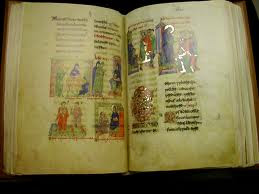Fiction or non-fiction, books come is many sizes, shapes, bindings and files. Some I've known, some I've read and some I haven't heard the name of even though I've sold them so I thought I'd lay them out for you. It is interesting to see which styles have disappeared over humanity's writing history.
The Tablet
Tablets were what we originally wrote on when it wasn't on walls or in caves. Stone, mud and clay were often used though stone is the most durable and that's why grave stones are by-and-large made of stone and concrete rather than wood or clay. Tablets are still in use but only rarely outside of the burial industry.
Scroll
This is a declaration scroll so it is a touch fancier than most old scrolls. Scrolls were first used after the invention of papyrus: a thick paper-like material made from the woven stems of the papyrus plant. A scroll was a sheet of papyrus or later paper curled in on itself, either from one side or both, with or without rollers. The papyrus or paper was rolled for portability and storage. Once widely used they are now mainly used in traditional practices like religious ceremonies, royal weddings etc. or in plays, for extra-classy invitations or for architectural designs (rarely rolled nowadays but still down).
Codex
Many books in one. Or, many scrolls (single books) bound together. The leaves are all of uniform size and are bound along one edge. The codex is the early beginnings of what we now generally call a book. It gained widespread popularity in the early Christian communities, possibly for cultural identification purposes, as most other types of communities still preferred scrolls.
Manuscript
When parchment became more popular than papyrus do to availability problems (political not environmental or agricultural) manuscripts were created. Almost all books were manuscripts copied by hand, making them expensive and comparatively rare. They were most commonly found in monasteries, papal libraries or in the property of royalty. If varied spelling and stylised writing isn't hard enough to read, spaces between words weren't commonly used before the 12th century. Vellum could be used instead of parchment. Only in Judaism is scribing manuscripts still widely done. According to custom, the Torah scroll can only be reproduced by hand. Manuscripts are otherwise extremely rare these days due to the labour involved and the high level of skill required.
Quarto
In printing and binding, the paper is folded twice, forming four leaves or eight pages approximately 11-13 inches (ca 30 cm) tall.
Octavo
The most common size for hardcover books printed today. The paper is folded three times into eight leaves or 16 pages up to 9 ¾" (ca 23 cm) tall. This is the type of book most authors hope to be printed in one day and when they do they'd like a first edition copy and a new ambition.
DuoDecimo
DuoDecimo is a size that falls between Octavo and Sextodecimo. It stands up to 7 ¾" (ca 18 cm) tall.
Sextodecimo
The paper is folded four times to form 16 leaves or 32 pages. It stands up to 6 ¾" (ca 15 cm) tall.
Folio
Stands up to 15" (ca 38 cm) tall. Commonly used in the printing of early plays.
Elephant Folio
Stands up to 23" (ca 58 cm) tall. Best used in photography or art books.
Atlas Folio
Stands up to 25" (ca 63 cm) tall. Large and perfect for detailed illustrations but not so good for portability. Best used in reference material.
Double Elephant Folio
Stands up to 50" (ca 127 cm) tall. Ridiculously large but great for detailed illustrations like this. As with the Atlas Folio this type of book is best used for reference material.
Codex Gigas
This is the Codex Gigas and it is 92 × 50 × 22 cm. It is the largest extant medieval manuscript in the world.
Booklet
Anything between 3 (ca 8 cm) tall - 5 ¾" (ca 13 cm) tall can be called a booklet. Often include less than 50 pages and are used mostly in business or ceremonies.
eBook
The book is a digital file that can be transferred or carried on various readers, digital storage devices and computers.















No comments:
Post a Comment